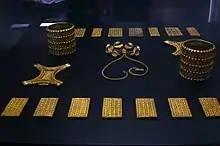Treasure of El Carambolo
The Treasure of El Carambolo (Spanish: Tesoro del Carambolo) was found in El Carambolo hill in the municipality of Camas (Province of Seville, Andalusia, Spain), 3 kilometers west of Seville, on 30 September 1958.[1] The discovery of the treasure hoard spurred interest in the Tartessos culture,[1] which prospered from the 9th to the 6th centuries BCE,[2] but recent scholars have debated whether the treasure was a product of local culture or of the Phoenicians.[3] The treasure was found by Spanish construction workers during renovations being made at a pigeon shooting society.[4][5]

It consists of 21 pieces of crafted gold: a necklace with pendants, two bracelets, two ox-hide-shaped pectorals, and 16 plaques that may have made up a necklace or diadem.[6] The jewelry had been buried inside a ceramic vessel.[7] Alternatively, some current thinking is that the plaques were attached to textiles adorning animals led to sacrifice, while the necklace and bracelets were worn by the priest officiating.[8] Following the discovery, archaeologist Juan de Mata Carriazo excavated the site. The treasure has been dated to the 8th century BCE, with the exception of the necklace, which is thought to be from 6th century BCE Cyprus. The hoard itself is thought to have been deliberately buried in the 6th century BCE.[5]
.jpg.webp)
Two distinct archaeological sites have been found at El Carambolo with the later replacing the first. One, on top of a hill, referred to as "Carambolo Alto" dates from the ninth to mid-eighth century BCE. Remains at this site consist mainly of burned huts and pottery with geometric designs. The first site reflects indigenous culture and is dated before the arrival of the Phoenicians. The second site, on the side of the hill facing the river, is known as "Carambolo Bajo." This site dates from the beginning of trade with the Phoenicians in the mid-eighth century. The Treasure of El Carambolo is associated with the second site and may have been buried at the time of the site's destruction in the sixth century.[9] The discovery of a statue of the Phoenician goddess Astarte cast doubt on the interpretation of the site as an indigenous settlement and led some to argue that it was more Phoenician than Tartessian.[10] Further excavations at the site revealed a Phoenician religious sanctuary.[11]
A 2018 study used chemical and isotopic analysis to try and resolve this debate over the hoard's provenance. The study concluded that while the jewelry was crafted using predominantly Phoenician techniques, the gold itself was sourced from mines only 20 kilometres (12 mi) away, likely the same mines which provided gold for the massive underground tombs at Valencina de la Concepcion.[5][12]
After years of displaying a replica while the original treasure was locked in a safe, the Archeological Museum of Seville has put the original artifacts on permanent display since January 2012.[13] A replica is on display in the National Archaeological Museum in Madrid.
Notes
| Wikimedia Commons has media related to Treasure of El Carambolo. |
- Chamorro, 197.
- "Sorry, Atlantis Believers! Scientists Say a Legendary Golden Hoard Did Not Originate from the Underwater City | artnet News". artnet News. 2018-04-12. Retrieved 2018-04-13.
- Perea and Hunt-Ortiz.
- Perea and Armbuster, 122.
- "Origin of Mysterious 2,700-Year-Old Gold Treasure Revealed". 2018-04-10. Retrieved 2018-04-13.
- Chamorro, 220-221.
- Chamorro, 220.
- As described and illustrated at the National Archaeological Museum (Madrid) display of their replicas.
- Deamos, 201.
- Deamos, 202.
- Flores and Azogue.
- Nocete, F.; Sáez, R.; Navarro, A.D.; San Martin, C.; Gil-Ibarguchi, J.I. (2018). "The gold of the Carambolo Treasure: New data on its origin by elemental (LA-ICP-MS) and lead isotope (MC-ICP-MS) analysis". Journal of Archaeological Science. 92: 87–102. doi:10.1016/j.jas.2018.02.011.
- Gómez.
References
- Chamorro, Javier G. (April 1987). "Survey of Archaeological Research on Tartessos". American Journal of Archaeology. 91 (2): 197–232. doi:10.2307/505217. JSTOR 505217.
- Deamos, María Belen (2009). "Phoenicians in Tartessos". In Dietler, Michael; López-Rui, Carolina (eds.). Colonial Encounters in Ancient Iberia: Phoenician, Greek, and Indigenous Relations. ISBN 978-0226148472.
- Fernández Flores, Álvaro; Rodríguez Azogue, Araceli (2005). "El Complejo Monumental del Carambolo Alto Camas (Sevilla). Un santuario Orientalizante en la Paleodesembocadura del Guadalquivir" [The monumental complex of Carambolo Alto, Camas (Seville). An Orientalizing Sanctuary in the paleodesembocadura of the Guadalquivir]. Trabajos de Prehistoria (in Spanish). 62 (1): 111–138. doi:10.3989/tp.2005.v62.i1.58.
- Perea, Alicia; Armbruster, Barbara (1998). "Cambio tecnológico y contacto entre Atlántico y Mediterráneo: el depósito de 'El Carambolo', Sevilla" [Technological change and contact between the Atlantic and the Mediterranean: the deposit of 'El Carambolo', Seville]. Trabajos de Prehistoria (in Spanish). 55 (1): 121–138. doi:10.3989/tp.1998.v55.i1.320.
- Gómez, Reyes (17 January 2012). "El Carambolo se exhibe 54 años después en una sala permanente del Arqueológico". El Mundo (in Spanish).
- Perea, Alicia; Hunt-Ortiz, Mark A. (2009). "New finds from an old treasure: the archaeometric study of new gold objects from the Phoenician sanctuary of El Carambolo (Camas, Seville, Spain)". ArchéoSciences. 2 (33): 159–163. doi:10.4000/archeosciences.2151.
External links
 Media related to Treasure of El Carambolo at Wikimedia Commons
Media related to Treasure of El Carambolo at Wikimedia Commons- Archaeological Museum of Seville - item description